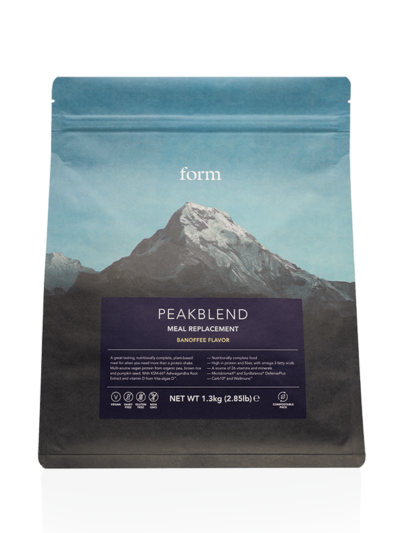‘Not Your Average Road Race’: The Complete Guide To Running an Ultra Marathon

So, you’re thinking of running an ultra marathon. If you’re a keen runner, you’ve likely considered the challenge at some point. An ultra isn’t just your average road race, where you spend a few hours pounding out a pre-planned course gunning for a time though.
They offer a much bigger challenge, centred around elevation, altitude, and even sometimes tricky-to-navigate terrain. They take a different type of patience and grit, with added elements of teamwork and reality-escaping. Sure, racing an ultra won’t be easy, but it’s nowhere near as time-pressured or competitive as traditional marathon running.
In sum, they’re a once-in-a-lifetime experience and a true adventure, happening all across the world on often beautiful trails. Some of the most famous ultras include the Last Desert in Antarctica, the Ultra-Trail du Mont-Blanc in Europe, and the Jungle Ultra in South America.
Piqued your interest? We’ve spoken to some of the best experts in the business to bring you a complete guide to ultra running, including how to train, both run-wise and strength-wise, plus exactly how to fuel up for the distance.

Credit: Ultra X
What Qualifies As An Ultra Marathon?
Technically, an ultra marathon is anything over your marathon distance of 26.2 miles, with 31 miles (50km) being the next big benchmark distance many race organisers stage. From there, 50 miles (80km), 62 miles (100km), and 100 miles (161km) are all pretty common distances.
Due to the total distance, you’ll sometimes be running for days (and days) at a time. The longest sanctioned ultra marathon is the Sri Chinmoy Self-Transcendence 3100 at – yep, you guessed it – 3,100 miles long. Taking place every summer in Queens, New York, it’s the longest certified footrace in the world. Runners have only 52 days to finish, racing from 6am to midnight each day.
When Did Ultra Running Become So Popular?
Ultra running has been on the rise for the last 15 years, says Jamie Sparks, co-founder of Ultra X, the first multi-stage ultra marathon series of its kind. “Once a niche alternative sport for the very tough, ultra running is now filtering out to the masses.”
That’s why they reckon Ultra X is so special: it’s one of the first businesses in the world to make ultra marathon running accessible to the masses. Fellow co-founder Sam Heward says that 40 percent of Ultra X finishers have never run a marathon before they took on an ultra marathon. He points out that stats like these twenty years ago would have been unheard of. “Our races are in truly extraordinary locations, and we love taking people on these life-changing adventures.”

Credit: Ultra X
So, How Do I Train For An Ultra Marathon?
Good question. Some can take up to six months of building up their mileage for events, some even longer. It all depends on your start point.
According to Carla Molinaro, run coach and team GB ultra runner, you don’t necessarily need a base level of fitness to run your first ultra, but you do need to give yourself enough time to train. Fun fact: last year, she became the fastest female ever to run the length of Britain, completing the whopping 874-mile distance in just 12 days, 30 minutes and 14 seconds. That’s 10 hours quicker than the previous attempt.
“Build up your training progressively and set realistic goals,” she recommends. If you have only run 10km, for example, then you shouldn’t aim to do a 100-mile run in ten weeks time. “That will backfire and probably make you never want to do one again,” she says. Setting your sights on a 50km race in six months time is more realistic. “You’ll be able to get there and get your body ready for the race in that timeframe,” she explains.
An Example Training Plan
Training examples are often too vague, as every ultra distance is different. “It completely depends on your current fitness level and how far the race you are training for is,” Molinaro explains. But, if you’re a running beginner and your current long run is 10km, she advises giving yourself five months to prepare. For the average runner running four times a week, Molinaro would normally include the following sessions in their weekly programme:
- An easy run
- Intervals
- A tempo run
- A long run
- Additional: yoga for runners session
- Additional: strength and conditioning session
“Depending on the type of ultra you are training for, you’ll have to run a lot further in your long runs. For example, if you’re training for just over a marathon distance, your longest run will probably be around 22 miles,” the coach shares. “For a 50-mile race, you’ll need to train up to about 35 to 40 miles,” she explains.
While you don’t need to focus on as much dedicated pacing work in ultra-training, you definitely need to keep those interval sessions in there, she stresses. Why? “They give your body a variation in pace and help you maintain running efficiency and good running form.” Basically, they get your body used to working when it’s pushed to its limit, which it likely will be during the real deal.

Credit: Ultra X
Is Strength Important When Training For A Long-Distance Race?
In a word: yes. Harvey Lawton, PT and founder of the The Movement Blueprint Running Foundations, stresses that strength training for ultra runners is critical for both building greater resilience and increasing speed endurance.
“Ankle stability, knee function and lower body strength play an integral role in ensuring runners have the ability to absorb and create force when running, without getting injured. Strength and stability through the lower limbs, hips and trunk also form pivotal components when running,” he explains.
Not convinced? It’s been scientifically proven, so don’t slack on the hip thrusts next time it’s your strength session. “Published research in the journal Sports Medicine lends itself to the view that greater eccentric strength can improve running efficiency for distance runners, while similar studies highlight the impact of strength training in reducing risk of injury to the lower extremities,” says Lawton.
“If your body’s structures aren’t conditioned, you’re not only capping your potential but leaving yourself open to far greater risk of injury.” In other words: don’t skip it. Below is what a strength session designed for ultra-running might look like.

Credit: Ultra X
Warm-up
5 x Ankle CARs (Controlled Articular Rotations) in each direction, right and left leg (R+L)
5 x Standing hip CARs (Controlled Articular Rotations) in each direction R+L
5 x Frontal plane lunge with forward reach R+L
Execute within a controlled range of movement.
*When performing joint CARs, ensure the joint in question is the only part of your body moving. Do this by creating tension and focusing on control and the quality of the movement throughout.
Complete 3 rounds, rest 20s between each movement
Stability
5 x Skater squat R+L
Raise heel if required – the intent is to control the downward phase.
12 x Walking lunge + rotation
Tto progress – load with a medicine ball or light kettlebell and focus on the stability as you rotate over the loaded leg each rep.
10 x Kettlebell suitcase march R+L
Use a heavy load for you. Focus on running mechanics and control with each march.
Complete 3 rounds, rest 30s between each movement

Strength
6 x Rear foot elevated split squat R+L
Load with dumbbells/kettlebells and build to a tough weight for you.
10 x Tall kettlebell lateral drag
Aim to keep your hips square and build to a heavy kettlebell.
Complete 4 rounds, rest 60s between rounds
Accessory Volume
20 x Tibialis anterior raise
Keep your legs straight and focus on isolating the ankle upwards.
10-15 x Single leg calf raise R+L
10 x Side plank clamshell
Complete 2-3 rounds, minimal rest required
Capacity
12 x Walking lunge
Load with dumbbells/kettlebells.
10 x Dumbbell renegade row
Keep your hips square throughout.
8 x Kettlebell swing
Target a heavy kettlebell, focusing on a dynamic hinge at the hip.
Complete 4 rounds of continuous work

How Do I Help My Body To Recover?
Molinaro warns that recovery is as important as getting the miles in when training for an ultra distance. If you don’t injury-proof your body, your hard work could go to waste.
Try Ice Baths
“Ice baths are great to help with recovery after long runs. If you can’t have an ice bath, a cold shower will also do the trick,” she explains.
Get Your Carbs In Quick
“Replacing your carbs as quickly as possible after a speed session or long run is vital. I tend to have a coke or a Mars milkshake as soon as I have finished. Then when you can, eat a meal with 20 grams of protein in to help your muscles begin repairing themselves.”
Prioritise Mobility
“Make sure that you are doing mobility. It’s absolutely essential for making sure your body is keeping mobile and stretched out after the tough sessions.”
Book In Your Sports Massages
“I’d recommend a sports massage every three weeks or so in the lead up to a big race. This will help you keep those niggles away, plus it helps stretch out your muscles.”
Sleep, Sleep, Sleep
“The only time that your body can repair itself is when you sleep. If you can dedicate at least one day a week to waking up without your alarm you will ensure that your body is getting the right amount of rest to help repair itself.”

How Do I Fuel For An Ultra Marathon?
Next up is nutrition, and it’s a biggie. Even when training for half or full marathons, nutrition is important, and you learn that refuelling for longer distances is recommended. But fuelling for an ultra is imperative. Without the correct fuel, your body simply won’t be able to complete the distance.
There is some research to indicate that a low carb, high fat diet is preferable in order to train the body to use the body’s fat storage during a prolonged low intensity race, but it’s an issue of debate in the academic and sports community. The research on high carb diets is more conclusive though.
Trialing Your Nutrition
Dr. Adam Collins, Form’s head of nutrition, suggests you follow a high carb diet for 24 to 48 hours before the race. “This is alongside no or minimal training, to top up glycogen stores,” he explains. As for during the race, aim for 60-90g of carbs per hour. “This could be real food, or gels, drinks, bars, jelly beans and Haribo. But remember they must be trialed beforehand. The most important thing is consuming foods your stomach can tolerate. Testing during your training is essential.”
Not sure what to try as your mid-race snacks? Higher GI foods are normally best as they’re less likely to cause gastric upset. Think simple carb sources that will provide you with enough energy to top up your depleted glycogen stores and you’re on the right tracks.
Renee McGregor, a leading sports and eating disorder specialist dietitian agrees, explaining that nutrition can make or break a race. But don’t panic – one of her top tips is consistency, and nailing your timing. “Studies have also shown that timing of nutrition, aka making sure you’re eating 30 mins before, during, and within 30 minutes of your session, has an integral role to play in hormonal balance, bone health and maintaining your immune system,” she explains.

A Breakdown Of Nutritional Guidelines
Follow these rough guidelines and you should be good to go:
- Low intensity or rest days: eat roughly 3g of carbohydrate per kg of body weight (BW) a day.
- 1 hour of training a day: eat roughly 5 to 7g per kg of BW a day.
- 1 to 3 hours of training a day: eat roughly 6 to 10g per kg BW a day.
- 4 to 6 hours of training a day: eat roughly 8 to 12g per kg BW a day. That’s roughly 360g of carbs for a 60kg woman training for an hour a day, and 640g of carbs for a 80kg man training for two to three hours a day.
For the 60kg woman, that could look like:
- Breakfast: 100g wholemeal bread (60g of carbohydrate)
- Lunch: 100g dry-weight pasta (75g of carbohydrate) with a beetroot, butternut squash and spinach salad (roughly 40g of carbohydrate)
- Snacks: An oat bar (30g carbohydrate) and a banana (25g carbohydrate)
- Dinner: A quinoa, sweet potato and veg bowl for dinner (80g carbohydrate)
- Dessert: Mango (20g of carbohydrate) and dates (72g carbohydrate) for dessert.
Your total daily intake would then be around 400g of carbohydrates.

Hydration
When it comes to how much water you should be drinking, there are no blanket rules. Climate, sweat rate and sweat composition can all play a part. Dr Collins explains that you will likely lose one to two litres per hour. “This means you’ll inevitably be dehydrated by the end of the race,” he says. “Your aim is to keep that dehydration to less than three percent of your body weight. My recommendation is to drink 750ml per 10km.”
And finally make sure you’re giving your muscles adequate recovery tools by refuelling with protein after each training session and after the race, Dr Collins advises.
The ultra isn’t for the faint-hearted, but if you follow the right training and nutrition it may be the experience of your life.


















